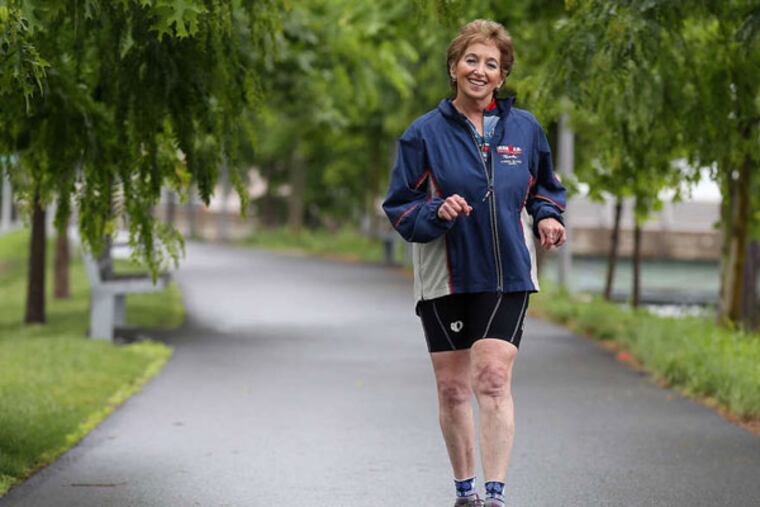Well Being: Scientist embraces challenges
Karen Glanz is a behavioral epidemiologist at the University of Pennsylvania. Much of her work focuses on applying the social sciences to encourage healthy behavior in individuals and communities. She studies the effects of the environment, nutrition, and exercise on obesity and the prevention of such ailments as cancer and heart disease.

Karen Glanz is a behavioral epidemiologist at the University of Pennsylvania. Much of her work focuses on applying the social sciences to encourage healthy behavior in individuals and communities. She studies the effects of the environment, nutrition, and exercise on obesity and the prevention of such ailments as cancer and heart disease.
Her work presents constant challenges, which Glanz relishes. It is also largely sedentary. As she puts it, "I spend a lot of time on my behind in front of a computer."
So Glanz tries to offset this by embracing challenges of another sort - robust physical activity often tied to an event.
In the fall, she cycled 300 miles across the Israeli desert, climbing 16,000 feet. In 2005, she pedaled 480 miles across Georgia. In 2002, chosen by lottery, she participated in the Ironman World Championships in Hawaii, finishing the 2.4-mile swim, 112-mile bike ride, and 26-mile marathon in 16 hours and 43 minutes. To qualify, she had to complete a half-Ironman in less than eight hours. She did so the day after flying in from the Netherlands.
At age 40, Glanz ran her first marathon. Over the last two decades or so, she has competed in more than 40 road races, duathlons, and triathlons.
"After all this time, it's just a part of who I am," says Glanz, of Bala Cynwyd. "It makes me feel good and less stressed, and I like the goal of a big event. It's a nice counterpoint to the more abstract goals I face at work. And as I've grown older, I've become increasingly aware that I might be doing something that helps me stave off aging."
For the record, Glanz, 60, looks 10 years younger.
She rises every day between 5 and 6 a.m., runs about four miles on a treadmill and then swims a mile, often at Penn's Pottruck Health and Fitness Center, before work. At least once a week, she commutes to her job by bike. On weekends, she typically cycles 20 to 40 miles. Right now, she is training for a 150-mile October ride to conquer cancer, from the Art Museum to Emmaus and back.
"After research team meetings, we'll be shooting the breeze, talking about the movies we saw over the weekend," says colleague and friend Amy Jordan, "and she'll say something casually about biking 65 miles the previous day. It just floors me."
As she was growing up in the suburbs of Cleveland, Glanz did not participate in sports or fitness activities, mainly because girls then were not encouraged. At the University of Michigan, she was a lifeguard and swam recreationally, and she continued to swim while doing graduate work at Michigan's public health school.
She began running in her mid-30s, influenced by a boyfriend and other friends who ran marathons. "I was curious, so I thought I would try it. I already had a lot of endurance from swimming."
As typically happens, she participated in short races, such as 5Ks and 10Ks, before working up to a half marathon. Her first was the Philadelphia Distance Run, which she finished when she was 38.
Two years later, she moved to Honolulu to do research at the University of Hawaii and ran her first marathon. "I was very slow and I felt worn down, but I was happy. I'm very goal-oriented, so getting the job done was rewarding in itself. And I got a T-shirt."
Glanz ran the Honolulu Marathon every year after that until 2004, when she moved to Georgia.
She runs a couple of half-marathons a year and estimates that altogether she has completed 15 marathons and 40 halfs. She has also participated in numerous triathlons, usually of shorter sprint and Olympic distances.
Like most endurance athletes, Glanz has had injuries. She has torn a meniscus, injured her hip through overuse, and broke an elbow when she was hit by a truck while cycling in Oregon. But such is her determination that she soon recovers and resumes. After surgery for her torn meniscus, she rehabbed her knee diligently and within a month ran a 5K.
Part of her professional work involves studying why people do or do not participate in healthy, preventative activity, such as eating well and staying active. It's not Glanz's style to lecture people about the importance of exercise.
"I try to be an example is more the way I operate. I'm not a superstar athlete or an Olympic specimen. But I think I have been able to influence my colleagues and people I work with in the community. I'm not a competitive athlete, although I do win my age group sometimes now because there aren't that many old gals out there, at least in the small races. So the message I try to impart is, 'If I can do it, you can, too.' "